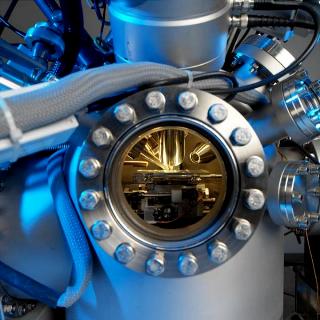Aug 11 2015
The National Physical Laboratory (NPL) worked with 20 laboratories across the globe to examine one of the most significant issues in Time-of-Flight Secondary Ion Mass Spectrometry (ToF-SIMS): the matrix effect. A new algorithm has been developed to overcome this effect allowing for better analysis of images in the future.
 Time of Flight (TOF) SIMS at NPL
Time of Flight (TOF) SIMS at NPL
Gas cluster ion beams (GCIB) have profoundly advanced the analysis of organic and biological material, such as polymer blends, optical devices, and organic light emitting diodes. By using surface analytical techniques, such as Time-of-Flight Secondary Ion Mass Spectrometry (ToF-SIMS), alongside GCIB sputtering (a process that removes the surface layer revealing a fresh, undamaged subsurface layer), depth profiles and three-dimensional reconstructions of the chemistry of the sample can be obtained. This can provide an effective means of visualising molecules with high sensitivity and excellent specificity.
Since the introduction of commercially available GCIB equipment, there has been a rapidly growing community of analysts employing GCIB with ToF-SIMS. However, there is a major weakness with this technique, which is the belief that an increased intensity in an image should be interpreted as an increase in concentration of the molecule in the sample. More often than not this is true, although the relationship is rarely linear, but occasionally it is decidedly false. The culprit is the irksome and poorly understood 'matrix effect', which has defied any description beyond phenomenology for many years.
Following on from previous work on the measurement and description of the matrix effect, NPL led a Versailles Project on Advanced Materials and Standards (VAMAS) inter-laboratory study. Two batches of samples with known compositions were produced at NPL and disseminated to 20 participating laboratories for analysis using ToF-SIMS and the well-established X-ray Photoelectron Spectrometry (XPS) technique, for comparison.
Most participants were able to return depth profiles for both techniques. However, with little guidance on how to overcome the matrix effects, most were unable to estimate the sample compositions with any accuracy using ToF-SIMS.
All data was returned to NPL for analysis. NPL found that the matrix effects were broadly similar for all types of instruments, allowing the development of an algorithm that would enable scientists to measure the unknown compositions with a very small error. The results of the study have been published in The Journal of Physical Chemistry B
This work represents a significant improvement in our understanding of the ToF-SIMS matrix effects, and a step towards extracting reliable compositional data from organic materials. It could also advance the study of biological samples, particularly identifying the distribution of drugs in single cells and tissue sections.
Earlier this year, NPL published an invited paper in a special issue of the International Journal of Mass Spectrometry, which was the first serious investigation of the matrix effect in organic secondary ion mass spectrometry.
Read the full paper: Measuring Compositions in Organic Depth Profiling: Results from a VAMAS Interlaboratory Study